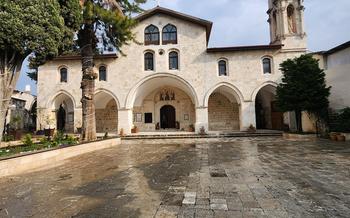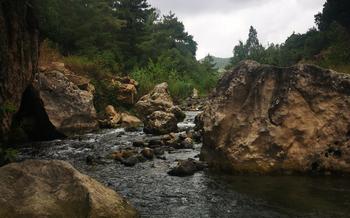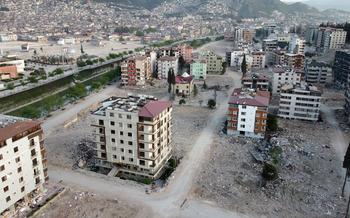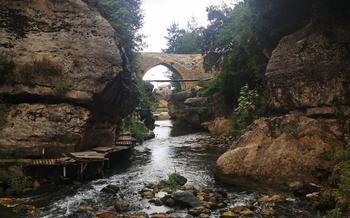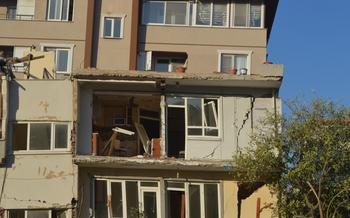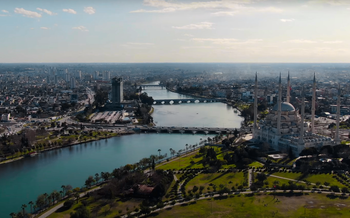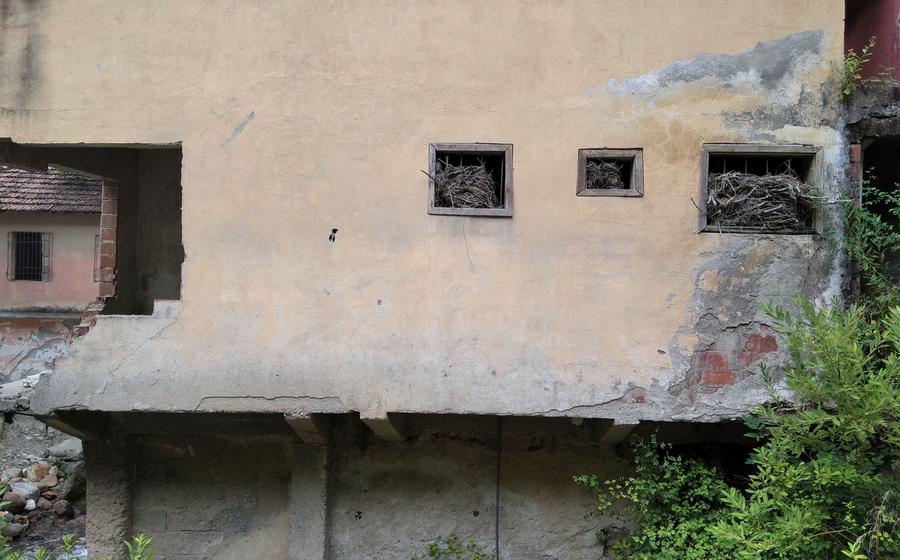
Hatay Bazaar
- Hatay Bazaar: A Cultural Melting Pot
- Exploring the City's Heritage
- Local Handicrafts and Treasures
- Gastronomic Delights
- Historical Sites Nearby
- Shopping Tips and Etiquette
- Textiles and Embroideries
- Local Sweets and Delicacies
- Artisanal Workshops
- Silver and Gold Jewelry
- A Culinary Adventure
- Local Pottery and Ceramics
- Historical Caravanserais
- Carpet Weaving: A Tapestry of Tradition and Craftsmanship
- Insider Tip: Making the Most of Your Bazaar Experience
Hatay Bazaar: A Cultural Melting Pot
Nestled in the heart of Hatay, Turkey, the Hatay Bazaar is a vibrant tapestry of sound, color, and aroma that captures the essence of this ancient land. With its roots deeply embedded in history, the bazaar has evolved into a cultural melting pot, where diverse ethnicities have harmoniously blended their traditions and customs, creating a unique and captivating atmosphere.
The bazaar is a testament to the rich cultural heritage of Hatay, a region that has been a crossroads of civilizations for centuries. Here, the air is filled with the scent of spices from the Middle East, the melodies of Turkish music, and the chatter of locals and visitors alike, all coming together to experience the magic of this bustling marketplace.
As you wander through the labyrinthine streets of the bazaar, you'll be amazed by the array of goods on display, from handmade carpets and intricate silver jewelry to traditional textiles and mouthwatering delicacies. Each item tells a story of the region's rich history and cultural influences, offering a glimpse into the soul of Hatay.
The bazaar is also a place where the art of bargaining thrives. Here, it's not just about getting the best price, but also about engaging in a cultural exchange, where both the buyer and seller come away with a sense of satisfaction. The friendly banter and good-natured haggling are all part of the experience, adding to the lively ambiance of the bazaar.
And let's not forget the gastronomic delights that await you at the Hatay Bazaar. From the crispy künefe to the creamy hummus and the tangy stuffed grape leaves, the bazaar is a haven for food lovers. The flavors of Hatay cuisine, influenced by centuries of cultural exchange, are a true reflection of the region's rich heritage.
Exploring the City's Heritage
The Hatay Bazaar is not just a place for shopping; it's a gateway to the city's rich history and heritage. Nestled within the ancient city of Antakya, the bazaar is surrounded by historical landmarks that speak to Hatay's diverse past.
The Church of St. Peter, one of the oldest churches in the world, stands as a testament to the city's early Christian heritage. The Hatay Archaeology Museum houses a collection of ancient artifacts that tell the story of Hatay's pre-Islamic past.
Walking through the bazaar, visitors can stumble upon hidden gems like the Ulu Mosque, built in the 13th century, and the Habib-i Neccar Mosque, which dates back to the 7th century. These historical sites offer a glimpse into Hatay's rich architectural and cultural heritage.
Cultural exploration and heritage tours are available for those who want to delve deeper into the city's past. These tours provide insights into Hatay's diverse ethnicities, their traditions, and their contributions to the city's unique cultural landscape.
Local Handicrafts and Treasures
The Hatay Bazaar is a treasure trove of local handicrafts and unique souvenirs. Discover the intricate designs of handmade carpets, each one a masterpiece of craftsmanship. Explore the stalls selling shimmering silver jewelry, adorned with precious stones and intricate patterns. Feel the softness of traditional textiles, woven with skill and love, showcasing the rich cultural heritage of Hatay.
Bargaining is an essential part of the bazaar experience. Engage with the friendly vendors, but remember to do so respectfully. Offer a fair price, but be prepared to negotiate. Your efforts will be rewarded with unique treasures that you'll cherish for years to come.
By supporting local artisans, you contribute to preserving the cultural traditions of Hatay. Each purchase tells a story of skill, patience, and dedication. Take home a piece of Hatay's craftsmanship as a reminder of your time in this vibrant city.
Gastronomic Delights
The Hatay Bazaar is a haven for food lovers, offering a tantalizing array of local delicacies that reflect the city's rich culinary heritage. From the crispy, cheese-filled pastry of künefe to the creamy, tangy hummus and the savory stuffed grape leaves, the bazaar is a culinary adventure waiting to be explored.
One of the highlights of the bazaar is the künefe, a sweet pastry made from shredded filo dough, filled with cheese, and topped with a sweet syrup. The künefe is a must-try for anyone visiting Hatay, and the bazaar is home to some of the best künefe makers in the city.
Another popular dish in the bazaar is hummus, a creamy dip made from chickpeas, tahini, and lemon juice. The hummus in Hatay is known for its smooth texture and rich flavor, and it is often served with fresh pita bread or vegetables.
For a taste of something savory, try the stuffed grape leaves, known as yaprak sarma in Turkish. These grape leaves are stuffed with a mixture of rice, herbs, and spices, and then wrapped and cooked in a flavorful broth.
The Hatay Bazaar is also a great place to explore the variety of spices that are used in Hatay cuisine. From the pungent aroma of cumin to the sweet, smoky flavor of paprika, the spices in the bazaar add a unique depth of flavor to the local dishes.
With its vibrant atmosphere, delicious food, and friendly locals, the Hatay Bazaar is a must-visit for anyone interested in experiencing the culinary delights of Hatay. Be sure to come hungry and ready to indulge in the many flavors the bazaar has to offer.
Historical Sites Nearby
The Hatay Bazaar is not just a place for shopping and culinary adventures; it's also a gateway to Hatay's rich history and cultural heritage. Situated within the ancient city of Antakya, the bazaar is surrounded by historical landmarks and archaeological sites that offer a glimpse into the region's fascinating past.
A short walk from the bazaar, you'll find the Hatay Archaeology Museum, home to a vast collection of artifacts from Hatay's ancient civilizations. Here, you can admire stunning mosaics, sculptures, and pottery that tell the story of the region's rich cultural heritage.
Another must-visit site is the Church of St. Peter, one of the oldest churches in the world. Built in the 4th century AD, this ancient church is a testament to the region's early Christian history. Its well-preserved architecture and beautiful frescoes offer a glimpse into the lives of early Christians in Hatay.
Venture a little further, and you'll discover hidden gems like the Ulu Mosque, with its striking architecture and serene atmosphere, or the Habibi Neccar Mosque, renowned for its unique blend of Islamic and Byzantine styles. These historical sites offer a fascinating glimpse into Hatay's diverse cultural and religious heritage.
Exploring these historical sites while visiting the Hatay Bazaar allows you to delve deeper into the region's rich past and gain a deeper appreciation for its cultural significance.
Shopping Tips and Etiquette
When shopping in the Hatay Bazaar, it is important to be respectful of local customs and traditions. Bargaining is a common practice, but it should be done respectfully and with an understanding of the cultural norms. It is not appropriate to offer extremely low prices or to haggle aggressively. Instead, start with a fair offer and be prepared to negotiate.
It is also important to recognize the value of handmade goods and to support local artisans. The items sold in the bazaar are often made by hand using traditional techniques that have been passed down for generations. By purchasing these goods, you are supporting the local economy and preserving cultural traditions.
Finally, be sure to take your time and enjoy the experience. Shopping in the Hatay Bazaar is not just about finding the best deals; it is also about immersing yourself in the local culture and interacting with the friendly and welcoming people of Hatay.
Textiles and Embroideries
The Hatay Bazaar is a treasure trove for textile enthusiasts, showcasing an array of intricate embroideries and colorful fabrics that reflect the region's rich cultural heritage. Visitors can marvel at the vibrant colors and delicate handiwork of traditional textiles, each piece telling a unique story. From intricately embroidered cushion covers to stunning tablecloths adorned with colorful motifs, the bazaar offers a mesmerizing display of local craftsmanship.
Discover the secrets behind the traditional techniques employed by skilled artisans, who have passed down their knowledge through generations. Learn about the symbolism and cultural significance of the patterns and motifs that adorn these beautiful creations. Each piece is a testament to the creativity and artistry of the local people, making them cherished keepsakes that capture the essence of Hatay's textile traditions.
Local Sweets and Delicacies
Indulge in the sweet side of Turkish cuisine at the Hatay Bazaar. Sample the legendary künefe, a crispy filo pastry filled with melted cheese and topped with sweet syrup. Delight in the flaky layers of baklava, filled with nuts and sweetened with honey. Bite into Turkish delight, a soft and chewy confection flavored with rosewater, pistachio, or other exotic flavors. Explore the variety of local pastries and desserts, each with its own unique story and taste. Discover the secrets behind the unique flavors and ingredients used in Hatay sweets, a testament to the region's rich culinary heritage.
Artisanal Workshops
Delve into the vibrant world of Hatay's artisanal workshops, where skilled craftsmen pour their hearts and souls into creating exquisite handmade goods. Witness the intricate process of carpet weaving, where vibrant yarns are transformed into masterpieces of color and design. Discover the art of silver and goldsmithing, where precious metals are shaped into beautiful jewelry adorned with intricate motifs. Observe the delicate touch of potters as they mold clay into elegant ceramics, each piece a unique expression of their artistry. Immerse yourself in the rhythmic sounds of looms as weavers create stunning textiles, their fingers dancing across threads to produce intricate patterns and designs. These workshops are a testament to Hatay's rich cultural heritage, where traditional crafts are not just preserved but celebrated and passed down through generations.
Silver and Gold Jewelry
The Hatay Bazaar is a treasure trove for jewelry enthusiasts, with a dazzling array of silver and gold ornaments handcrafted by skilled artisans. From intricate necklaces and earrings to delicate bracelets and rings, each piece showcases the region's rich jewelry-making traditions.
The designs are a harmonious blend of traditional motifs and contemporary influences, reflecting the cultural heritage of Hatay. Intricate filigree work, colorful gemstones, and intricate engravings adorn these exquisite creations, making them a feast for the eyes.
Discover the symbolism and cultural significance behind each piece, as many designs carry deep-rooted meanings and are believed to bring good luck, protection, or prosperity. Whether you're looking for a unique souvenir or a special gift, the jewelry stalls in the Hatay Bazaar offer an unforgettable shopping experience.
When bargaining for jewelry, remember to approach the sellers with respect and politeness. Start with a fair offer and be prepared to negotiate. Remember, the price is not set in stone, and a friendly conversation can often lead to a better deal.
A Culinary Adventure
Indulge in a culinary adventure as you explore the Hatay Bazaar, where the air is filled with tantalizing aromas and the flavors of Hatay's rich cuisine come alive. Savor the delectable kebabs, grilled to perfection and seasoned with aromatic spices. Bite into the crispy lahmacun, a traditional Turkish flatbread topped with minced meat, vegetables, and herbs.
Don't miss the opportunity to sample the meze platters, an assortment of small dishes that showcase the diverse flavors of the region. From creamy hummus and tangy baba ghanoush to yaprak sarma, tender grape leaves stuffed with rice, pine nuts, and currants, each bite is a culinary delight.
Venture into the bazaar's many restaurants and eateries, where you can savor the flavors of Hatay in a more relaxed setting. Try the local specialty, künefe, a sweet and savory pastry made with shredded filo dough, cheese, and syrup.
As you explore the bazaar's culinary delights, you'll discover the unique flavors and spices that define Hatay cuisine. From the smoky aroma of cumin to the vibrant red of Aleppo pepper, each ingredient adds a layer of complexity to the region's dishes.
Indulge your senses and embark on a culinary journey through the Hatay Bazaar, where the flavors of Turkey's culinary heritage come together in a symphony of taste.
Local Pottery and Ceramics
The Hatay Bazaar is a treasure trove for pottery and ceramics enthusiasts. Local artisans showcase their skills in creating colorful and intricate pieces that reflect the region's rich artistic heritage. Admire the vibrant glazes, delicate patterns, and unique shapes that characterize Hatay pottery.
Discover the traditional methods used to create these beautiful works of art. Watch as skilled potters mold clay into various forms, using techniques passed down through generations. Learn about the firing process and the intricate glazing techniques that give Hatay pottery its distinctive look.
Each piece of pottery tells a story, reflecting the culture and traditions of the region. Discover the symbolism behind the patterns and motifs, often inspired by nature, history, or local folklore. These unique pieces make for meaningful souvenirs that capture the essence of Hatay's craftsmanship.
From decorative plates and vases to intricate tiles and figurines, the Hatay Bazaar offers a diverse collection of pottery and ceramics. Whether you're looking for functional items to enhance your home décor or unique gifts to cherish, you'll find something special among the stalls.
Historical Caravanserais
Nestled amidst the labyrinthine alleys of the Hatay Bazaar, you'll stumble upon the vestiges of a bygone era - the historical caravanserais. These architectural gems, once bustling with traders and their caravans, now stand as silent witnesses to the rich history of trade and commerce in this ancient city.
Step through the arched gateways of these caravanserais and be transported back in time. Their courtyards, once filled with the sounds of haggling merchants and the braying of camels, now offer a serene respite from the lively bazaar. Admire the intricate stone carvings and architectural details that adorn these historic structures, each a testament to the craftsmanship of their builders.
Imagine the caravanserais in their heyday, when they served as essential resting places for weary travelers and their laden camels. Merchants from distant lands would gather here to exchange goods, share stories, and forge new alliances. The air would have been filled with the exotic scents of spices, the clinking of coins, and the hum of conversation in a multitude of languages.
While the caravanserais no longer serve their original purpose, they continue to hold a special place in the heart of Hatay. Today, they house shops, cafes, and galleries, offering visitors a glimpse into the city's rich past while providing a unique backdrop for modern-day commerce.
As you explore these historical caravanserais, let your imagination run wild, picturing the vibrant tapestry of life that once unfolded within their walls. They are a reminder of the enduring legacy of trade and the cultural exchange that has shaped the unique character of Hatay.
Carpet Weaving: A Tapestry of Tradition and Craftsmanship
Amidst the bustling alleys of the Hatay Bazaar, visitors can discover a treasure trove of vibrant carpets, each a masterpiece of traditional craftsmanship. The art of carpet weaving holds a special place in the cultural heritage of Hatay, where skilled artisans pour their hearts and souls into creating these intricate textiles.
Step into a carpet workshop and witness the mesmerizing process of carpet weaving. Watch as nimble fingers deftly maneuver the colorful threads, transforming them into intricate patterns that seem to come to life. Each carpet tells a unique story, reflecting the rich history and cultural traditions of the region.
From the vibrant colors of nature to the intricate geometric designs, every carpet is a testament to the skill and creativity of Hatay's master weavers. Discover the symbolism embedded in the patterns, each motif carrying a special meaning and representing a different aspect of Hatay's rich cultural heritage.
Whether you're looking for a unique souvenir or simply admiring the artistry, the Hatay Bazaar is home to an exceptional collection of handmade carpets. Find a piece that resonates with you and take home a piece of Hatay's vibrant cultural tapestry.
Insider Tip: Making the Most of Your Bazaar Experience
To fully immerse yourself in the vibrant atmosphere of the Hatay Bazaar, consider arriving early in the morning before the crowds gather. This will give you ample time to leisurely browse the stalls and engage with the friendly vendors. Remember to wear comfortable shoes, as you'll be doing a lot of walking on the cobblestone streets. To enhance your experience, learn a few basic Turkish phrases for bargaining and communicating with locals. This will not only help you get better deals but also show respect for the local culture. And don't forget to try some of the delicious local street food for a taste of authentic Hatay cuisine. From freshly baked pastries to grilled kebabs, there's something for every palate to savor.
